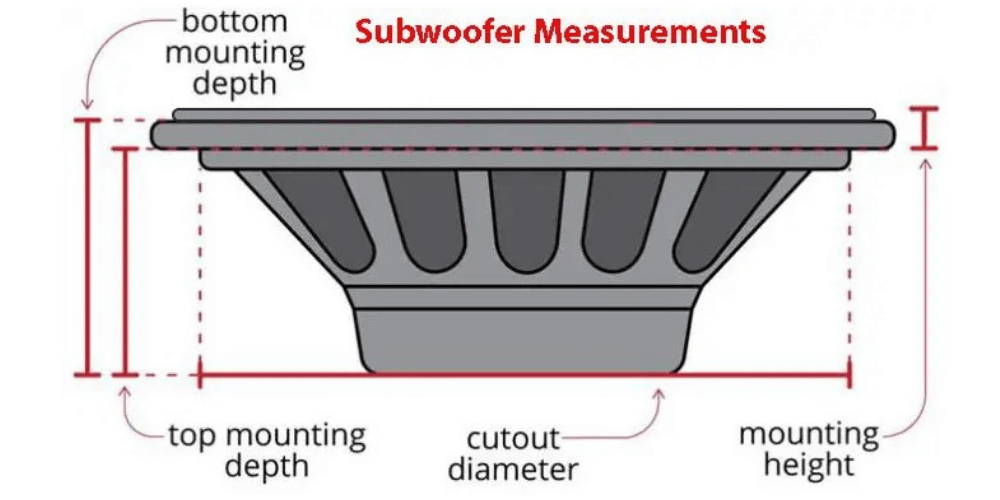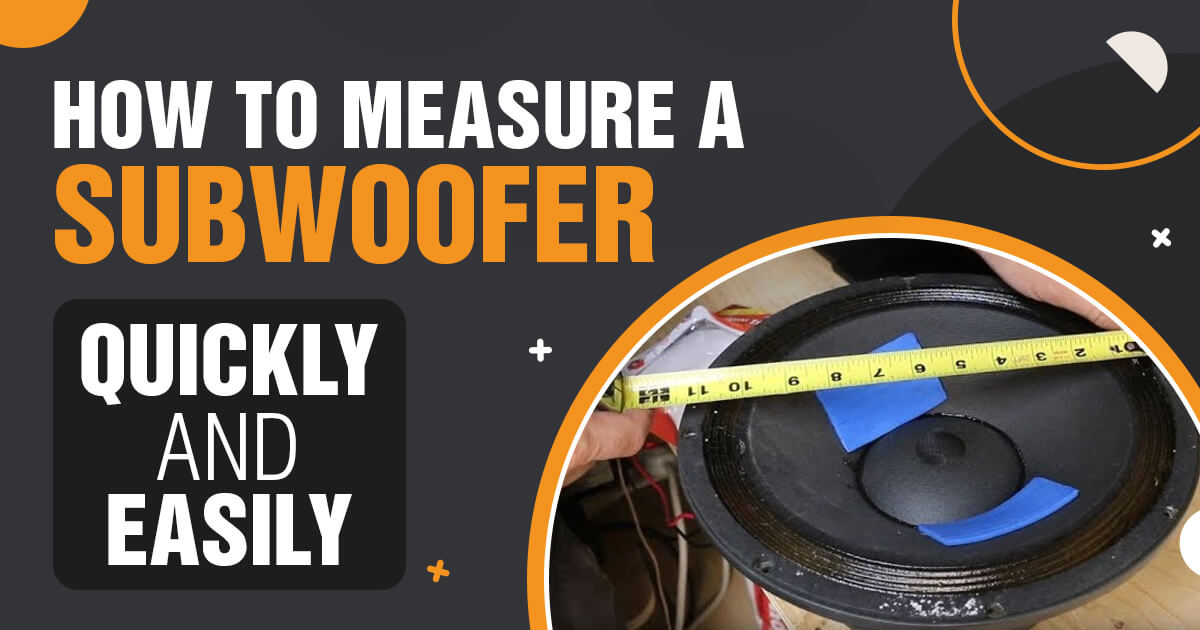With this guide, we will show you the easiest and quickest way to get the job done.
Many of us enthusiasts have seen or heard about other methods, but they can be time-consuming and confusing.
But with our process, it is effortless and straightforward to where anyone could do it within a few minutes! So let’s get started!
Subwoofer Sizes Explained
Before you learn how to measure a subwoofer, you have to know its size.
Subwoofers come in all shapes and sizes, so we first need to break down a few terms used to describe them…
Although there are multiple terms used to describe various sizes, the two most common subwoofers are the Compressed Horn Subwoofer and Regular Subwoofer.
Compressed Horn Subwoofers are usually less than 10 inches in size and can be found in cars, boats, and motorcycles.
Regular Subwoofers are larger than 10 inches and include home theater subwoofers, car audio subwoofers, etc.
To measure a subwoofer accurately, you will need to know its diameter, so we recommend using a tape measure.

What Aspects Of A Subwoofer You Should Measure?
The size of your subwoofer is determined by three measurements: diameter, mounting height, and depth.
Remember, subwoofer measurement is not just about the size (10” or 12″ subwoofer) of your speakers.
With the wide range of subs, you can find one that fits your sound and preference.
Here’s an illustration showing these measurements:
Speaker diameter: The length of a subwoofer is the measurement across its frame, not including any mounting lugs.
Cutout diameter: This is an essential measurement of the subwoofer. It includes the places for mounting it to a wall or holes.
This is necessary so that the surround and woofer cone don’t hit anything when it goes on top.
Mounting height: This is the measurement from top to bottom of your subwoofer sticking out from where it is mounted.
It is necessary because a subwoofer that is too low will touch a surface and vibrate, which causes the sound to lose its impact.
If it’s too high, it won’t hit the surface with enough force to make any impact at all.
Mounting depth: This is a handy way to determine how far your speaker will be placed from the front of an enclosure, and it only takes seconds.
So it gives your system an accurate bass response without any overpowering resonance or feedback noise.
How to measure subwoofer size?
Method 1: Measure Subwoofer Dimensions
Step 1 – Remove the Subwoofer Driver from the Old Enclosure
You will need to turn off the subwoofer and remove it from its enclosure or mounting.
You can use the screwdriver to take off covers in front and back, then loosen screws or detach wires as needed for removal.
You need to make sure that the driver is entirely out of the enclosure.
Step 2 – Measure the Subwoofer’s Mounting Depth
The subwoofer should sit with its cone facing upwards. The mounting depth is how far you can put the speaker away from the wall.
Measure both top and bottom mounting depths to calculate the depth of your speaker.
That is measured from the flat metal or plastic plate surrounding it as well as what you’re sitting on – in this case, carpeting.
This will allow proper tuning since we want all frequencies below our target range (below 20Hz) coming out!
Step 3 – Measure the Mounting Heights
This means measuring from the bottom of the subwoofer to the highest point on it.
To ensure a proper bass response, place the subwoofer so that its wide part faces up.
Next, measure from the bottom to top where it meets with other parts around it like metal or plastic frames, and make a note of this measurement as well!
Make sure to measure the height of the mounting plate from the bottom.
Then you need to see how far it reaches from the frame.
Keep in mind that you need this measurement to ensure your subwoofer is safe.
Subwoofer safety is essential, so keep the subwoofer height does not extend too far.
Plus, measure it correctly for your enclosure and ensure they are within guidelines!
Step 4 – Measure the Cutout Diameter
As the last instruction, you need to measure the cutout diameter. Let’s talk about this in detail with the following explanation.
To ensure that the widest part of the cone is down, you have to flip your subwoofer upside down.
Measure the diagonal size of the subwoofer driver from one mount hole to another, then note them for future reference.
Method 2: Measure Mounting Holes
You can use this method to calculate your subwoofer’s dimensions accurately, and it will allow you to drill new holes in an enclosure if needed.
Here’s how:
Step 1 – Determine the Mounting Hole’s Outer Diameter
Find the hole that is the biggest.
Put your ruler across it, so you can see how wide it is.
Mark the edge of the hole with your marker or pencil.
Now measure up to see how long it is.
If the hole is not round, make sure to check it on all sides.
Step 2: Determine the Hole’s Inner Diameter
If you have a problem with where you want to mount your subwoofer, this is a crucial step.
You should measure the size of the inside of the hole.
Usually, a ruler can be used for this.
Measure both lengthwise and breadth of your intended mounting location before going any further with this step.
If all goes well after these preparations have been made, then installation should proceed smoothly!
Step 3 – Measure the Subwoofer Space Depth
If you have a problem with where you want to mount your subwoofer, this is a crucial step.
You should measure the size of the inside of the hole.
Usually, a ruler can be used for this.
Measure both lengthwise and breadth of your intended mounting location before going any further with this step.
Step 4 – Determine the Unique Features Of The Screw Pattern
Before installing your new subwoofer, check the pattern of the old enclosure.
Determine distances between screw holes by figuring out which ones are opposite each other.
Then find out how far apart those screws were concerning others around them on either side or behind it.
You should also note if there isn’t enough space between other holes because this may be an issue.
If the pattern of the screws is not like your other screws, you can drill new ones so they can work.
Also Read: What does clipping mean with subwoofers?
Subwoofer Size Chart
The Subwoofer Size Chart has four types of subwoofers. They are 8 inches, 10 inches, 12 inches, and 15 inches subwoofers.
If you are looking for a high-quality and good-sized subwoofer, this size chart is perfect.
It helps determine which one will work best with your car or home.
| Subwoofer sizes | 8 inch | 10 inch | 12 inch | 15 inch |
| Weight | Lightweight | Lightweight | A little bit heavy | Heavier |
| Space Consumption | Take less space because the cone is smaller | Take less space | Take some more space. | Take a large space |
| Watts(RMS-Peak) | The minimum power of 300 watts and a maximum of 1200 watts. | The minimum power of 150 watts and a maximum of 1200 watts | The minimum power of 50 watts and a maximum of 1200 watts or even 1300 watts | The minimum power of 600 watts and a maximum of 5000 watts |
How are subwoofers measured?
Subwoofers are measured by their power handling, frequency response, and impedance. Power handling is measured in watts and describes the maximum amount of power the subwoofer can handle without damaging the speaker.
Frequency response is expressed in Hertz (Hz) and describes the range of frequencies a subwoofer can reproduce. Impedance is expressed in ohms and describes how much electrical resistance a subwoofer has. Higher impedance generally means a higher quality subwoofer.
Physical size:
Subwoofers are also measured by their physical size, which is important for determining how much space is required for the subwoofer.
The size of a subwoofer is typically given in cubic feet (ft3). It is important to note that the size of a subwoofer does not necessarily correlate with its power and sound quality.
Sensitivity:
Finally, subwoofers are also measured by their sensitivity. This is expressed in decibels (dB) and describes how efficiently a subwoofer can convert power into sound. The higher the sensitivity, the louder and more efficient the subwoofer will be.
Subwoofers are an important part of any audio system, and understanding how they are measured can help you choose the right one for your needs.
How to measure a 12-inch subwoofer?
Measuring a 12-inch subwoofer is a fairly straightforward process.
- First, locate the mounting holes on the subwoofer. These are typically located on the outer edge of the subwoofer cone. Measure the distance between the two mounting holes. This measurement should be equal to 12 inches. If the measurement is not equal to 12 inches, the subwoofer is not a 12-inch subwoofer.
- Next, measure the diameter of the subwoofer cone. This measurement should be approximately 12 inches. If the diameter is not equal to 12 inches, the subwoofer is not a 12-inch subwoofer.
- Finally, measure the depth of the subwoofer. This measurement should be equal to 12 inches. If the depth is not equal to 12 inches, the subwoofer is not a 12-inch subwoofer.
- By following these steps, you can easily measure a 12-inch subwoofer and determine if it is the right size for your application.
Conclusion
There are several ways to measure the quality and performance of your subwoofer.
However, if you’re looking for an easy way that will give you essential data points in minimal time, this is it.
We hope these measurements will help you to make some educated decisions!
If not, please let us know what other information you need from our blog post or website.

